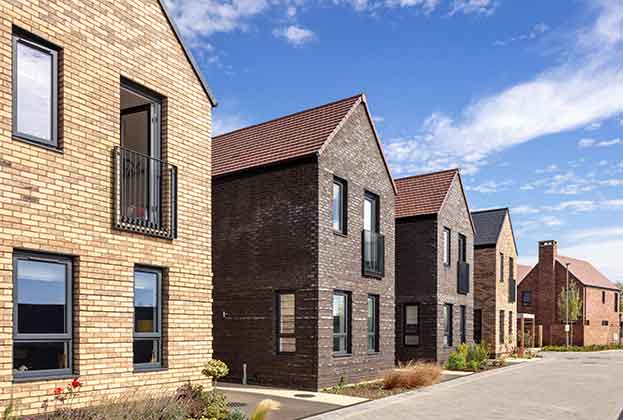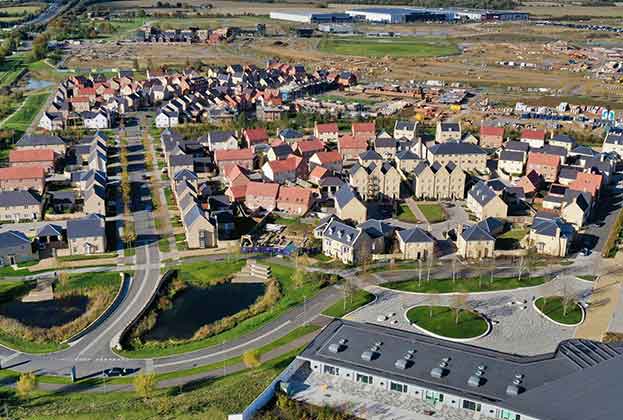What are Build to Rent Houses and why do we need them?
Who lives in Build to Rent Houses?
There is a large pool of rental demand in suburban markets, which are popular with young families. The supply of new homes to rent has previously focused on urban markets, whereas rental demand is much larger in suburban locations (54% compared to 35% in urban markets).
Our survey identified that local amenities are the number one priority for SFH tenants, according to our Savills Single Family Housing Investor Survey. This means proximity to local schools, green spaces and health services, given the high proportion of families living in these homes.
Aimed at working families and co-renters, the offer is better quality than the wider PRS – properties will be cheaper to run with fewer maintenance costs, given they are newer homes
Guy Whittaker, Associate, Head of UK Build to Rent Research
People tend to move further to access these homes, indicating that new rental homes that are professionally managed with good connectivity to schools and transport are attracting renters from further afield.
Suburban locations with access to road networks are an important attribute for single family housing schemes, as most workers are car-dependent.
These renters are either young families or young couples who are looking to start a family and/or settle into a more permanent community, and so are searching for a long-term product.
We would expect in the future to see the spread of ages shift to more closely match the wider PRS, as families stay in SFH through children’s school years so there is a balance of established families as well as new families moving in.
.jpg)
The incomes of households living in SFH are above average compared to the wider PRS. As a consequence, the median amount that Single Family households spend on rent is 25% of gross income. This is slightly less than the median spend in the English PRS (33%) and within what the ONS defines as affordable rent (less than 30% of gross income).
Using data provided to us by the research sponsors, the most common employment sector for SFH tenants is ‘Professional occupations’, which is a fairly broad category. This group includes nurses, teachers and social workers and is much more common in SFH (31%) compared to the wider PRS (19%).
The next top 4 largest occupier groups are broadly similar in proportion to the wider PRS. This suggests that SFH is catering to a wide range of employment sectors and incomes.
Welsh Streets appears to be an ideal home for key workers. The 254 houses are currently home to 90 key workers from the Health & Social Care, and Education & Research occupation groups
Guy Whittaker, Associate, Head of UK Build to Rent Research
What attracts people to Build to Rent Houses?
Our survey participants rate their developments highly. Ascend is the largest manager of operational single family housing in the UK and manages on behalf of PRS REIT and Gatehouse Investment Management. Each investor has consistently reported high occupancy rates and high renewal rates.
The PRS REIT reported 98% occupancy across its 5,129 homes in September 2023. This implies residents are satisfied with their housing choice and that those who move out are quickly replaced by new tenants.
The homes are optimally located – just a five-minute drive from two hospitals and several schools. They are also at a price point that meets the needs of key workers
Guy Whittaker, Associate, Head of UK Build to Rent Research
According to our Savills Single Family Housing Investor Survey, local amenities are the number one priority for tenants. In practice, this means proximity to local schools, green spaces and health services, given the high proportion of families on SFH sites. SFH developments are characterised by high levels of connectivity to local infrastructure with all schemes near main roads.
Ease of access to major roads is important given around two-thirds of households drive to work in markets with operational SFH sites. Nearly all schemes have access to bus stops, primary schools, GP surgeries and dental practices.
Residential property review site Homeviews also found high levels of satisfaction among SFH residents, 83% rated their home as either “Excellent” or “Very Good”.
It is increasingly difficult for prospective tenants to find properties because the number of homes available to rent nationally has greatly reduced. The reduction in portal listings results from a combination of factors, including tenants staying in properties for longer, with tenancy lengths increasing, so fewer properties are becoming available to re-let.
There has also been a significant increase in the number of private rental properties being listed for sale. Two and three-bedroom supply is the most constrained nationally. SFH is well-placed to support that segment of the market.
In Q2 2023, a survey by the NRLA suggested that at least in the short term, there are far more landlords intending to sell property in the next 12 months (43%) than buy (10%). With the prospect of further house price falls in 2024, it is unlikely that many investors will be actively looking to expand their portfolios.
Higher interest rates will also make it difficult for renters to get out of the PRS by buying a home, keeping rental demand high.
How many rental homes do we need?
To assess future rental demand, we have used the propensity of different age groups to rent and applied these to government household projections.
These projections point to an additional 800,000 to 1,000,000 Private Rented Sector households by 2031, under three scenarios.
Our base case scenario identified that between 2021 and 2031, the greatest growth in the number of PRS households will be in the 25–34-year-old age group, with an additional 370,000 during this period.
There will be an additional 229,000 35–44-year-olds.
Other scenarios involved a ‘Help to Buy 2’ stimulus or an ‘Affordable Home Building Programme’.
Our projections indicate that a stimulus package similar in scale and impact to Help to Buy would soften future PRS demand by 20% (c.200,000 households) and an affordable homebuilding programme would soften demand by 11% (c.110,000 households).
While a Help to Buy 2 would deliver more houses, it would come at the cost of fuelling further house price inflation, which has the dual effect of (i) pushing home ownership further out of reach for middle-income earners, whilst (ii) simultaneously putting increased pressure on PRS rents.
What are the benefits of Build to Rent Houses?
There are a number of benefits for local authorities (LAs) in securing investment in suburban rented homes.
The number of LAs with SFH in their construction pipeline has grown steadily from just 4 in 2013 to 114 in 2023, which encompasses 33% of LAs in England and Wales. Large-scale investors can help support the delivery of energy-efficient, sustainable homes that are available to rent for the long term. Single family housing has an important role to play in upgrading the quality and energy efficiency of the nation’s overall housing stock.
23% of privately rented homes in England are non-decent. Whilst this has halved since 2006, it is still more than twice as many as homes owned by Housing Associations (9%) and LAs (10%).
Between 2017 and 2021, the proportion of non-decent owner-occupied homes fell from 19% to 13%, and the proportion owned by Housing Associations fell from 15% to 9% over the same period. Meanwhile, the proportion in the Private Rented Sector only fell 2%, from 25% to 23%.
72% of SFH homes have been delivered with EPC ratings of ‘B’ or above, whereas only 12% of existing privately rented dwellings meet this standard. 90% of investors we surveyed are targeting a minimum of EPC ‘B’ across their portfolios, with 20% targeting a minimum of EPC ‘A’.
They aim to reduce the embodied carbon and lifetime emissions of their developments and meet their commitments to achieving Net Zero.
This is supportive of the government’s decarbonisation ambitions for the UK, pledging to reach Net Zero by 2050. Many investors are looking to incorporate highly sustainable features into their developments.
Increase housing delivery
- Homes are ‘additional’ as new stock is created rather than recycled between tenures
- Accelerates delivery as homes can be let faster than they can be sold
- Speeds up delivery of local infrastructure (schools, roads)
Improves housing stock
- New build housing improves the quality of overall housing stock
- Improved energy efficiency of homes
- Synergy with Modern Methods of Construction
Placemaking & mixed communities
- Capital injection in early phases helps to establish early placemaking
- Affordably-priced homes for local families
- Supports a multi-tenure approach with mixed-tenure communities
- Improved energy efficiency of homes
- Refurb model regenerates and revitalises deprived areas
Read the other articles within The Future of Build to Rent Houses – Summary Report below
.jpg)

